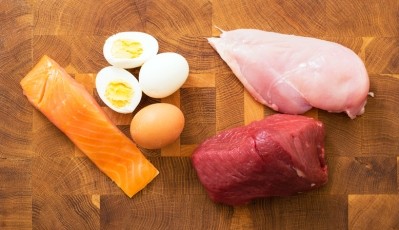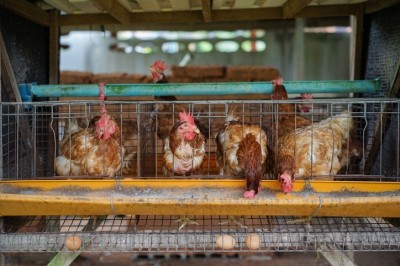Fatty acid enhanced pork, beef, and milk products likely to follow: Devenish
Omega-3 enriched meat and eggs brings consumer health benefits: study

Professor Alice Stanton, associate professor of molecular and cellular therapeutics at the Royal College of Surgeons Ireland (RCSI), who led the trial, presented the results at the American Heart Association Scientific Sessions Conference in California, on November 14.
The Northern Ireland firm’s algae derived, OmegaPro product, was the source of the omega-3 Polyunsaturated Fatty Acids (PUFA) in the chicken and eggs used in the study; the same product enriched the omega-3 chicken range that UK supermarket group, Waitrose, launched in June last year – those birds are reared on Moy Park farms in Northern Ireland.
Clinical trial
The RSCI led clinical trial evaluated 161 subjects who consumed at least three portions of omega-3 enhanced chicken and eggs per week over a six-month period.
The findings, said the authors, indicated a hike in omega-3-PUFA levels in the participants’ blood and a positive shift in what is described as the ‘omega-3 Index’- a test that measures the amount of fatty acids, Docosahexaenoic Acid (DHA) and Eicosapentaenoic Acid (EPA) in red blood cell membranes, which reflects the levels in the heart and other tissues.
A low omega-3 Index (<4%) indicates a heightened risk of heart and brain disease. The trial showed that consuming fatty acid enriched chicken and eggs over the six months resulted in a halving of the number of subjects with such a high-risk omega-3 Index, said the researchers.
“We certainly believe that from the blood responses that we got in our clinical study that, when omega-3-PUFAs are provided as part of a complete diet, they are bioavailable in terms of, actually, being able to shift the blood pattern,” Dr Heather Hayes, director of food innovation with Devenish, told us.
“We see the more omega-3 enriched food sources you have, on a little and often basis, the higher the bioavailability than just taking a single dose of [omega-3 fatty acids] through a supplement,” she continued.
Alternatives to oily fish
While omega-3s from salmon are in a form that is highly bioavailable, she noted that many people do not tend to eat that much salmon and other oily fish: “But we are not trying to compete with salmon; instead, we want to provide complementary alternatives for people who don’t like fish, and that applies particularly to children.”
Traditionally, fish oils have been used to supply EPA and DHA in the diet, but Hayes said: “I think that is possibly changing as well. I think the big problem with fish oils is that they tend to be highly variable and, unfortunately, many fish oils tend to be highly oxidized. Whereas algae, from our point of view and in terms of using it as a raw material, we know it is highly consistent, we know it is sustainably produced, and we know it is protected from oxidation.”

She said there is an increasing focus on algae production, driven by the need to develop sources of alternative long chain fatty acids for farmed fish production.
“There is a lot more focus on algae, a lot more product coming onto the market. I would say that within each individual supplier, consistency, in terms of our experience, has been very high. We are buying it to a particular specification of omega-3 fatty acids. We do extensive testing on it, and we are getting consistent recoveries on it, in the feed and in the bird.”
In terms of disclosure around the composition of OmegaPro, the Devenish representative said she was, somewhat, restrained by proprietary issues, but explained: “OmegaPro is very much a product designed around delivering the levels we need in the animal though a specific feeding program, as well as delivering the levels of actual fatty acids in the feed itself. There are other components of OmegaPro that enhance the uptake and deposition of the fatty acids. However, it is more than just a product; it is a concept around the feeding programs required and, obviously, that further links in with the clinical studies as well.”
OmegaPro can be included at levels up to 15% in finisher and withdrawal diets, to achieve the desired level of omega-3 fatty acids. For broilers, it can be fed from 21 days before slaughter and for laying hens, eggs typically will reach their stabilized level within 21 days of feeding, said the producer.
“We have conducted numerous trials to optimize the feeding program so that we deliver the levels [of fatty acids] we need over a range of body weights that will be retailed into the market.”
Omega-3 enriched pork, beef, and milk products
In terms of where Devenish is at, currently, in the application of the OmegaPro feeding strategy to other production segments such as beef, pork and milk, Hayes said:

“We have a lot of ongoing work in our own food innovation division. Ultimately, the aim is to be meet consumers’ daily requirements for omega-3 – from DHA and EPA in particular – from enrichment of a range of foods.
“The research is well progressed, certainly on the pig side. Like poultry, pigs are monogastrics and that makes it slightly more straightforward as the deposition pattern in the meat is a direct reflection of what you feed the animal. From a ruminant point of view, it is slightly more complicated, in that when you feed a ruminant something, and it goes into the rumen, it changes quite notably. Therefore, a lot of our work on the enrichment of ruminant products is very much focused on what actually happens when it goes into the rumen, and what we can to do to protect it, as such.
“We have research projects aimed at delivering fatty acids unchanged into the small intestine. If we get it [OmegaPro] through the rumen successfully, what we don’t, as yet, know is how efficient the animal is in depositing it in the meal and, ultimately, that will determine how cost effective it is in the animal, as they deposit it at different rates.”
In terms of omega-3 added milk products, the enrichment process is even more complex: “The same principle applies but milk [enhancement] is slightly more difficult again. Not only have you to get it [OmegaPro] into the small intestine but you have to get it into the mammary gland as well – a bit of a double whammy for us. However, again, that is part of our ongoing research program. I think it is very important to target milk, to get it into milk products, particularly for the benefit of children – and that is very much on our radar.”
Linking animal and human nutrition
Having worked in animal nutrition for many years, she said this field of research offers a very novel slant on animal nutrition and how it actually affects the people that eat the end product.
“Animal nutrition has, historically, been focused on animal health, performance and wellbeing so it is nice to cross the divide into human health and human wellbeing. Devenish has actually been quite foresighted to see that link and to understand we have a guardianship in terms of consumer health; it is not just about providing commodity products at the cheapest price, it is about providing something that is good for the consumer.”
It is also about consumers recognizing that each stage in the chain has an effect, she said.
“The consumer has got to understand that when faced with the choice of buying something for €1 that is mass produced versus buying something at an extra premium that is good for their health. I think we have a responsibility to educate the consumer in that respect.”
Bone density in animals
Devenish has also been exploring the impact of feeding the algae based product to broilers and layers, from a performance perspective, with insights from in-house work and from independent studies showing benefits to the birds in terms of bone strength and bone density. That work continues, she added.








